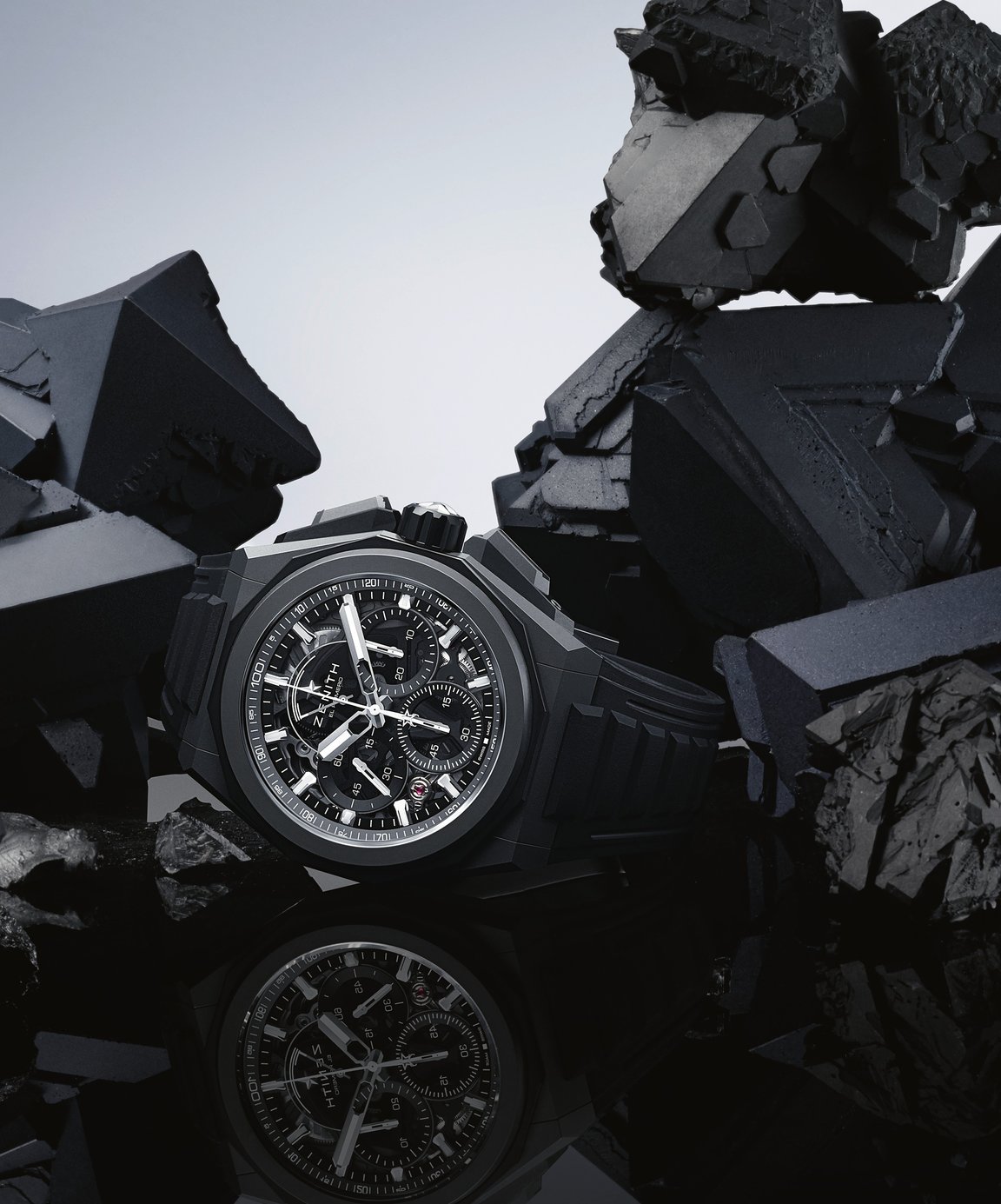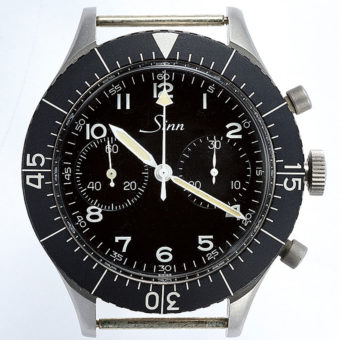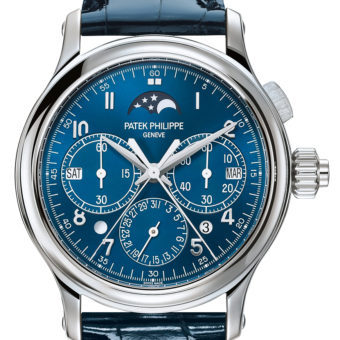This article was originally published in the May/June 2022 Issue of the WatchTime print magazine.
Zenith built the El Primero, the world’s most accurate chronograph, in 1969. But now the manufacture has increased its beat frequency from 1/10 to 1/100 of a second. We took a look at what the fastest mechanical watch can do with its many facets.
With the introduction of the first automatic chronograph caliber El Primero in 1969, Zenith already had the fastest stopwatch on the market. At a frequency of 36,000 vibrations per hour, the movement has been able to measure time intervals with an accuracy of 1/10th of a second for over 50 years. In 2017, the manufacture revived the Defy El Primero and introduced a chronograph capable of measuring to 1/100th of a second.

Now the Defy Extreme is the brand’s most modern and technical model in terms of design. Though generously sized at 45 mm across, the anthracite-gray titanium case appears slimmer on the wrist. Zenith achieves this effect with a fine, bead-blasted treatment.
Many details of this watch catch the eye. The dial is perfectly round on top but 12-sided beneath. The rectangular push-pieces are arranged in a “V” shape and have a sloping outer edge, a groove and a protective guard that is secured with a hex socket screw (a complex shape in itself). Plus, there’s a quickchange strap system which, though undetectable from the outside, connects any of the three supplied straps to the case to look like an integrated attachment.
The dial is just as complex. It consists of a sapphire crystal dial base with polished and beveled indexes filled with luminous material and broad hands that follow this shape with different angles. The applied counters have beveled rings, printed tracks and sapphire crystal centers with printed numerals. The polished Zenith star logo is also applied. A power-reserve display for the chronograph is placed at 12 o’clock. The movement can be seen between the counters and through their transparent centers, including galvanically blackened, skeletonized and satin-finished bridges, as well as the balance wheel for the gear train. This wealth of variety may seem extravagant, but the Defy Extreme has a clarity that does not look overloaded, even though this level of detail is not ideal for overall legibility.

As usual, the Defy displays the hours and minutes from the center, and has a small seconds subdial at 9 o’clock. The big show begins when you press the pusher at 2 o’clock: the central stopwatch hand takes off and sprints around the dial in a single second while indicating the 100 increments marked on the inner flange. The speed is impressive, unlike most any other mechanical watch, and no wonder — the Defy Extreme is currently the fastest chronograph and the fastest mechanical watch anywhere. The understated but clearly audible sound reminds us of a racing bike running in its highest gear.
The hundredths of a second can be read on the outer track. However, when the chrono function is engaged, the hand does not always land exactly on the line. Sometimes it falls between two lines, so precise reading is not always possible. But because human reaction time is around 0.2 seconds (which corresponds to 20 marks on the hundredths track), this has a minimal effect on measuring accuracy. The 60-second counter at 6 o’clock and the 30-minute counter at 3 o’clock are a harmonious presentation of hands and tracks, clearly showing the maximum measurable time span of this chronograph of 30 minutes. By that point, the central hand will have taken 180,000 steps, as many as a standard El Primero chronograph after five hours, and the power reserve display for the chronograph will have been passed the halfway mark. The barrel for the stopwatch function stores enough power for 50 minutes of running time.

The numbers tell the whole story: a fast 1/100th-second chronograph needs a lot of energy. For that reason, it cannot, as usual, run alongside the timekeeping mechanism. The primary gear train for the Defy Extreme runs at 36,000 vibrations per hour and has a corresponding balance that is typical for the El Primero. The chronograph mechanism is completely isolated and has no gears in common, just sharing the space between the mainplate and bridges. And the chrono mechanism is amazingly fast. Its balance wheel clocks at 360,000 vph, which you can also see through the caseback. Surprisingly, it is comparable in size and shape to a standard balance wheel.
The stopwatch mechanism also has its own barrel. And while the primary gear train is wound automatically by the star-shaped rotor, the chronograph power is provided by winding the crown manually. This is also unique — automatic winding for the time and manual winding for the stopwatch function.
The rate results show another advantage of the complex architecture. Normally, the watch movement powers the chronograph hand and this, because of its energy needs, can negatively affect the oscillation of the balance wheel and consequently the rate results. Complete separation of the two mechanisms means the primary timekeeping remains unaffected.

We checked this on our timing machine, the Chronoscope X1. This high-end watch testing device for mechanical watches has the newest technology for measuring the performance of mechanical watch movements. We tested the watch in all six positions, and the average calculated deviation of the Defy Extreme was clearly in the negative range, at -4.5 seconds per day, but the individual positions differed by only 6 seconds, which is a good result. The balance amplitudes were stable.
Quick-release systems for the bracelet or strap are trending in the watch world, but many of these solutions do not seem fully developed. Often, changing the strap is not as easy or the stability is not as great as promised.
Zenith’s solution, however, is excellent. On the one hand, the straps connect securely to the case and have a nicely integrated look with no gaps. And on the other, the system is easy to use. Press the center button on the back of the spring bar with a fingernail to release. You will need a good amount of pressure, but in return, the system is extremely secure — it can’t be triggered accidentally. Clicking the halves of the strap into place is very simple and is designed to prevent the case from getting scratched.
Also very positive, Zenith supplies three different and high-quality straps, including a bead-blasted titanium bracelet that matches the case perfectly. It has a double folding clasp with two safety release buttons and fits comfortably on the wrist.

The supplied textile strap has a rubber base and a Velcro closure. The strap is pulled through a double-D buckle and then secured with the hook-and-loop section. The adjustment range is limited, the strap is a bit stiff, and opening it completely is awkward due to the thicker, stitched Velcro section.
Our favorite is the third option — a rubber strap that makes this large watch very comfortable to wear. The asymmetrical folding clasp is easy to operate, has secure release buttons, and can be adjusted over a wide adjustment range.
Just like the case and dial, the bracelet and both straps are nicely finished. There are few that compare. But this is also true for the price. At $18,000, this watch is in the upper price range.
Still, this spectacular and unique 1/100th-second chronograph — with its separate balance wheel and barrel — is comparable in its complications to a perpetual calendar or even a tourbillon. And with the added bonus of three high quality straps and its complexity, quality and workmanship, this watch is compelling. The buyer gets a true record-breaking watch with a spectacular visual impact — the fastest mechanical watch on the market today.
Zenith Defy Extreme Specs:
Manufacturer: Zenith SA, Rue des Billodes 34-36, 2400 Le Locle, Switzerland Reference number:
97.9100.9044/02.1001
Functions: Hours, minutes, small seconds, chronograph with 1/100th-second, 60-second and 30-minute counters, power-reserve display for chronograph
Movement: In-house movement El Primero 9004, automatic, chronometer, 36,000 vph for time indication, 360,000 vph for chronograph, column-wheel control, 53 jewels, stop seconds, Kif shock absorber, Glucydur balance wheel, hairspring made of Composite Carbon Nanotube Matrix, Triovis fine regulation, power reserve = 50 hours for time indication, 50 minutes for chronograph; diameter = 32.8 mm, height = 7.9 mm
Case: Bead-blasted titanium, flat sapphire crystal with anti-reflective coating inside, screwdown crown, 4 screws on caseback with sapphire crystal viewing window, water resistant to 200 m
Strap and clasp: Titanium bracelet with safety folding clasp, rubber strap with titanium safety folding clasp, textile strap with Velcro closure
Rate results: Deviation in seconds per 24 hours
Dimensions: Diameter = 45 mm, height = 15.4 mm, weight = 137 g
Price: $18,000
Scores:
Strap and clasp (max. 10 points): It comes with three excellently finished options — in titanium, rubber and textile. 9
Case (10): Clean finishing of the complex titanium case with screw-down crown, water resistant to 200 meters, very nice quickchange strap system. 9
Dial and hands (10): Complex construction with faceted markers and hands, printed sapphire crystal dial with beveled black track rings. 10
Design (15): Modern, technical, complex design. Beautiful facets in a variety of angles. 13
Legibility (5): Broad hands with luminous material do not provide good contrast against the busy dial, the 1/100th-second hand does not always land on its markers. 3
Operation (5): The deeply grooved crown and the large, smoothly operating pushers are easy to use, stop-seconds mechanism is on board, the quick-change strap system functions well. 5
Wearing comfort (5): Despite its size, it is very comfortable to wear, especially with the rubber strap. 5
Movement (20): Innovative in-house movement has a separate barrel and balance wheel for the chronograph function. It runs at a record breaking tempo of 360,000 vph, allowing for 1/100th-second timing. The blackened and skeletonized movement also has brushed finishes. 18
Rate results (10): Unfortunate drop in the negative range, but the individual values do not vary much. Engaging the chronograph does not affect the rate. 6
Overall value (10): The high price can be explained by the refined complication, very clean workmanship, a complex structure, and a refined strap-changing system with three supplied straps. 8
TOTAL: 86 points
To learn more about Zenith, click here, and to subscribe to the WatchTime print magazine, click here.







Impressive time piece and beautifully executed.